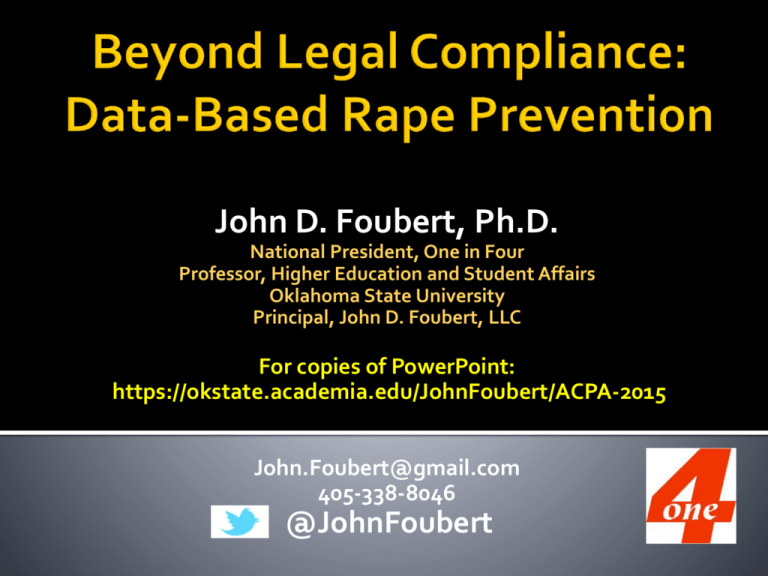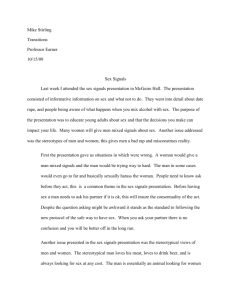
John D. Foubert, Ph.D.
National President, One in Four
Professor, Higher Education and Student Affairs
Oklahoma State University
Principal, John D. Foubert, LLC
For copies of PowerPoint:
https://okstate.academia.edu/JohnFoubert/ACPA-2015
John.Foubert@gmail.com
405-338-8046
@JohnFoubert
1.
2.
3.
4.
5.
6.
7.
8.
Key Elements of Campus SAVE
Prevalence of Sexual Violence
Characteristics of Targeted Women
Perpetrator Behavior
Title IX vs. Yes Means Yes
Helpful Theories & Research re: Prevention
4 Approaches to Prevention
Q&A and Discussion
Every institution who uses federal financial aid
Annual Security Report
Available programs for DV, Dating Violence, Sexual
Assault and Stalking
Standard of evidence
Possible sanctions
Provide programs:
rape, acquaintance rape, domestic violence, dating
violence, sexual assault, and stalking.
Primary prevention and awareness programs for
incoming students, new employees, ongoing prevention
and awareness programs for students and faculty. Must
include:
▪ statement prohibiting 6 crimes above
▪ Definition (state) of domestic violence, dating violence, sexual
assault, and stalking
▪ Definition of consent
▪ Bystander Intervention
▪ Risk reduction to recognize warning signs of abusive behavior
A prompt, fair, and impartial investigation and
resolution of cases
Annual training for investigators/hearing officers
about:
domestic violence, dating violence, sexual assault,
and stalking,
how to conduct an investigation and hearing
process that protects the safety of victims and
promotes accountability
The Campus SaVE Act codifies
mandate for prompt and impartial internal
investigation and resolution procedures
requirement that alleged sexual assault victims be
advised of their right to file internal complaints,
criminal complaints, or both.
DCL mandates “preponderance of the evidence”
standard
SaVE Act states only that institutions must specify the
standard of evidence they will use
Congress did not disavow preponderance standard
Checklist from United Educators:
https://www.ue.org/Libraries/Corporate/The_Cam
pus_SaVE_Act_A_Compliance_Guide.sflb.ashx
Title IX & Sexual Assault Guidance from OCR
http://www2.ed.gov/about/offices/list/ocr/docs/qa
-201404-title-ix.pdf
• 3.1% of college women
survived rape or attempted
rape during a 6-7 month
academic year.
• 10.1% survived rape before
then.
• 10.9% survived attempted
rape before then.
•
Fisher, Cullen & Turner; US Department of
Justice, 2006
3.1
10.1
+ 10.9
24.1%
Current College Women: 673,000 women
have experienced rape at some point in their
lifetime
(Kilpatrick, Resnick, Riggiero, Conoscenti & McCauley, 2007).
Annually: In one year 300,000 college
women, over 5% of women enrolled in
colleges and universities, experienced rape or
attempted rape.
(Kilpatrick, Resnick, Riggierio, Conoscenti, & McCauley, 2007; American College Health
Association, 2013).
3% of college men report surviving rape or
attempted rape (Tjaden & Thoennes, 2006).
16% of males were sexually abused by the age
of 18
(Dube et al., 2005).
Between 6 and 9% of men admit
committing rape in anonymous surveys
(Abbey & McAuslan, 2004; Lisak & Miller, 2002).
Breaking News: It is on the way up…
On an average campus of 10,000 students
10,000 students, if ½ are women:
5,000 women
5% experience rape/attempted rape per
academic year
250 women annually
about 1 per day.
Those who have experienced
rape are 20x more likely to
report difficulty being assertive
Some demonstrate delayed
response to cues to dangerous
situations
2 x or more weekly binge drinking
Peer support
Emotional
Physical
Sexual violence
(DeKeseredy & Schwartz, 2014)
“Women lie about not wanting sex”
Low empathy.
More sexually active
Women are sexual objects to be conquered
Women and men should have separate and proper roles
Needs to control women.
Behave in rigidly and stereotypically masculine ways
Hate perceived slight to their masculine identities.
Aggression and violence marker of his adequacy.
(Lisak & Miller, 2002)
Title IX requires proof of “unwelcomeness”
Easier to prove than lack of “affirmative
consent.”
Acquiescence in the conduct or failure to
complain does not mean the conduct was
welcome.
Conduct is unwelcome if a student acts out
of fear, or because her capacity is
diminished due to alcohol or drugs.
“Yes means yes” -- if a person does not want sex, a
forcible attack is allowed so long as the offender claims he
made a “mistake” about “affirmative consent.”
Under Title IX “unwelcomeness,” standard such
“mistakes” are not allowed.
”Unwelcome”
a person subjectively does not want sex.
a student did not "request or invite" it and if she "regarded
the conduct as undesirable or offensive.”
(Wendy Murphy, 2014, personal communication)
DOESN’T WORK AS FOCUS
Getting men to focus on
respecting women’s “no”
Not having sex with women
who are intoxicated
Not expecting sex (i.e. as a
payment for dinner)
Not interpreting women’s
flirting, dress, and behaviors
as an invitation to sex
Challenging gender
stereotypes and belief of
rape myths
WHAT WORKS
Teaching men to support
survivors
Teaching men to act as
allies to women.
Men don’t see information
on left as relevant to them.
They see information on
right as relevant.
To produce lasting attitude change,
interventions must be designed to maintain
people's existing self-conceptions
(Grube, Mayton & Ball-Rokeach, 1984).
Behavior Change is Most Likely When
People Are:
Motivated to hear the message
Can Understand it Well
Perceive it as Personally Relevant
(Petty & Cacioppo, 1986)
Motivated
Understand
Relevant
No
Yes
Central Route
Processing
Peripheral Route
Processing
Lasting Change
Experts
Trustworthy
Attractive?
Yes
No
Short Term
Change Likely
No
Change
Single Sex (Brecklin & Forde, 2001)
Empathy Based (Schewe, 2002)
Describes Male-on-Male Rape (Schewe)
Includes Bystander Education (Banyard, Plante &
Moynihan, 2004)
Goal is to give everyone the skills to
intervene and reach out to help others.
Hard to say “this doesn’t apply to me.”
Conditions Necessary to Intervene:
Notice a Situation
Interpret as emergency
Decide it is your responsibility to
act
Know what to do
Act
1.
2.
3.
4.
5.
6.
Make prior commitment to help
Sense of responsibility for situation
Believing the victim has not caused it.
Self-efficacy about what to do
See others modeling bystander behavior
Perceiving that the victim is a member of
your group.
Banyard, V. L., Plante, E. G., & Moynihan, M. M. (2004). Bystander education: Bringing a broader
community perspective to sexual violence prevention. Journal of Community Psychology, 32, (1), 6179.
Bring in the Bystander (Victoria Banyard, UNH)
Bystander efficacy, willingness, rape myth acceptance
Mentors in Violence Prevention (Jackson Katz)
Lower levels of sexism, increased belief that they could prevent
violence against women
Green Dot (Dorothy Edwards)
Rape myth acceptance and increased bystander intervention
The Men’s and Women’s Programs (John Foubert)
Decline in sexual assault behavior, rape myth acceptance,
increase bystander willingness and efficacy, increase in
empathy
(Banyard, Moynihan & Plante, 2007; Banyard, Plante & Moynihan, 2004; Cissner, 2009; Coker, Cook-Craig, Williams,
Fisher, Clear, Garcia & Hegge, 2011; Foubert, Newberry & Tatum, 2007; Langhinrichsen-Rohling, Foubert, Brasfield,
All-Male
Primary Focus:
Empathy
How to Help Survivor
Bystander Intervention
Lowers the rate of sexually coercive behavior among
high risk men by 40%.
Decreases the severity of sexually coercive behavior
among high risk men eight fold.
Increases empathy toward female rape survivors.
Two years after program participation, 79% of
participants reported either attitude or behavior
change due to the program’s effects or that the
program reinforced their current beliefs.
Increases bystander intervention.
(Foubert, Godin & Tatum, 2010; Foubert & Newberry, 2006; Foubert, Newberry & Tatum, 2007; LanghinrichsenRohling, Foubert, Brasfiled, Hill, & Shelley-Tremblay, 2011).
Video interviewing perpetrator.
How to help friends avoid guys like him
How to help a friend who survives rape.
Interactive exercise about intervening as
bystanders.
Commitment to intervening.
Significant increases in bystander efficacy
Significant increases in bystander willingness to help
Greater ability to recognize risk cues
Greater willingness to engage in self-protective
behaviors
Greater level of self-efficacy in handling threatening
dating situations
Foubert, J.D. & Langhinrichsen-Rohling, J., Brasfield, H., & Hill, B. (2010). Effects of a rape awareness program on college
women: Increasing bystander efficacy and willingness to intervene. Journal of Community Psychology, 38, 813-827.
Bannon, R. S. (2014). The bystander approach to sexual assault risk reduction: Effects on risk recogniation, perceived selfefficacy, and protective behavior. Doctoral Dissertation.
Resources
Foubert, J.D. (2011). The men’s and women’s programs: Ending rape through peer education.
New York: Routledge.
Foubert, J. D. (2011). The women’s program: Peer educator’s guide. New York: Routledge.
Foubert, J. D. (2011). The men’s program: Peer educator’s guide. New York: Routledge.
Thoughts?
Questions?
Comments?




